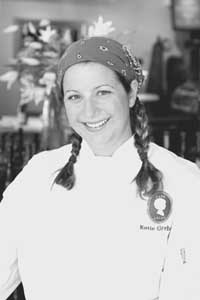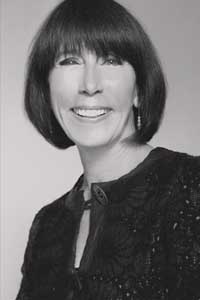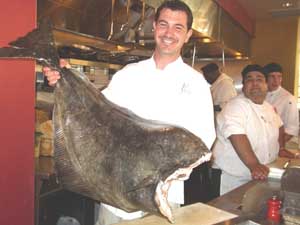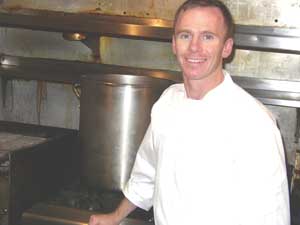-
- Losses on ballot measures jolt religious right
- Fired Colo. evangelist apologizes for his ‘sexual immorality’
- Republican Sen. Rick Santorum loses seat
- Pro-gay woman takes over divided Episcopal Church
- Texas tries to shake its anti-gay image
- Missouri State sued by student who refused to support gay adoptions
- National News Briefs
- World News Briefs
feature
Q&A with San Diego’s trailblazing chefs
Published Thursday, 09-Nov-2006 in issue 985
No less than five years ago, San Diego could not have tooted its culinary horn loud enough to snag the attention of national food critics or seasoned restaurant goers. We were merely a wannabe food destination boasting only a handful of notable kitchens respected more for their surf-and-turf suppers and pleasing seaside locations than for their creative prowess.
Yet rapid building development combined with a steady influx of new residents from cities spawning celebrity chefs and world-renowned restaurants has helped to change that. San Diego County is now home to an impressive posse of trailblazing chefs who have dramatically raised the bar on what sits on our plates when dining out. They’ve nudged us closer to the bigger league of food capitals such as New York, Los Angeles, Chicago and San Francisco.
For example, the Nov. 15 issue of The Wine Spectator, which is published nationally, features a glowing article on San Diego’s burgeoning restaurant scene, citing such stellar names as Bertrand at Mister A’s, the new 1500 Ocean, Molly’s in the San Diego Marriott & Marina Hotel and the well-respected Mille Fleurs. It also points out that 23 local restaurants have received the magazine’s Award of Excellence rating in the past few years, a critical and progressive achievement to any dining scene angling to be taken seriously by a world audience.
Additionally, global restaurant and travel guides such as Frommer’s, Zagat and Gayot.com, for example, have beefed up their San Diego dining sections in the past few years, giving residents and visitors a deserving taste of the high-caliber meals San Diego now has to offer.
While consumers and food critics continue debating the merits of San Diego’s dining status, we’ve deferred to some of our master chefs to get their inside perspectives on how we’re doing.
Katie Grebow, executive chef at Café Chloe
“Compared to cities like New York, I see that the service skills among wait people are still lacking, particularly when it comes to knowing where the cheeses and fish and meats originate. In New York, the wait staff is more knowledgeable about the origins of the food and wine they’re serving. On the other hand, it’s nice to see restaurateurs investing in their atmospheres. A lot of the décor used to be more generic hotel-style. I’m also seeing more classic European dishes served in casual, cozy ways all over town, such as at Vagabond and Modus and here at Café Chloe, where we offer a bistro-like atmosphere instead of the high-end French approach, and where meals like steak frites are easier to appreciate.”
Mike Davis, executive chef at Dobson’s
“I think the local food scene has been getting better and better in the 12 years that I’ve lived in San Diego. I used to work at Pamplemousse, which was rated No. 1 in the Zagat Guide for years. Now, other chefs around town are starting to push the limit and create some really good food. It’s a challenging effort every day to come in and produce consistent quality meals. Local competition among chefs is helping to raise the standard by working with fresh seasonal products, such as white truffles in autumn, game meats in the winter, Mexican sea bass and heirloom tomatoes in the summer. We’re also seeing more restaurants working with high-quality wines. Or when customers bring in their own expensive bottles, your serving staff has to be knowledgeable about the food parings and the chef should be ready to come out and assist, if only to meet and greet everybody. In the higher-end restaurants lately, the chefs are more accessible. For today’s customers swept up in food television shows, it’s the highlight of their day.”
Ingrid Croce, proprietor of Croce’s Restaurant and Bar
“Because San Diego has now become a true dining destination with more and more fine-dining restaurants and Wine Spectator Awards, there are also many events taking place throughout the year around food and wine. I think it is very important to educate staff about upcoming food and wine events held in our city so that they can pass along their knowledge to guests and also partake and sample all that San Diego has to offer. I’ve also observed a more heightened awareness of wine lists in our dining scene: wine pairings, wine flights, more extensive wines by the glass and an increased popularity in half bottles so that guests can explore and learn on their own. In the future, I believe we will see more sommeliers at San Diego restaurants, as we do in San Francisco and New York, as people are becoming more knowledgeable at a younger age about food and wine.”
Tony DeSalvo, chef and co-owner of Jack’s La Jolla
“When I first came here two years ago, I didn’t feel there was a lot of growth in the dining scene. Now there’s a lot more attention to food and more risk taking. What we lack, though, are the ultra-adventurous restaurants, a reflection that we are still a little further behind. But I don’t think that’s a bad thing. What I see is definitely more attention paid to local farms and producers of beef, poultry and fishing. And rather than just buying from Chino Farms, we’re seeing more chefs using other local providers such as Brandt Beef, Crow’s Pass, La Milpa Organica. I think that when you have great products from those places, chefs don’t have to overdress the food because they let the products speak for themselves. This is a general trend. San Diego chefs are also showing a real commitment to building a food community. I see more of an individuality of restaurants, less of them with prevalent themes and more that are carving out their own identities and building their own personalities and soul.”
Brian Sinnot, executive chef at Molly’s
“The San Diego dining scene is definitely getting better, with more variety and upscale restaurants. Chefs and consumers have become more in tune to local products from smaller farms, offering things like strawberries, apples and a bigger variety of lettuces. We’re taking more of a slow-food approach with focused and intelligent menus [as] opposed to fusion that doesn’t make sense when you have so many different styles of cuisine on one menu. As far as using new and unfamiliar ingredients, we’re getting there and bringing those ideas to San Diego from other cities. A growing number of chefs are being drawn to San Diego because the reputation of our dining scene has improved and because of the building up of downtown, where there’s now more of a vibe. Before, most of the upscale restaurants were centered in La Jolla. Also, having cooked in Washington, D.C., and San Francisco, I think that chefs here are more willing to support each other through friendly competition. There’s more camaraderie for the betterment of our dining scene.”
Christian Graves, executive chef at Jsix
“As the new kid on the block, and coming here from San Francisco just six months ago, I see that the local chef community is really committed to make the dining scene grow. In San Francisco it’s more cutthroat. The food here is very ingredient driven, which is what you want from a chef. My peeve, however, is when chefs try breaking the sound barriers with sauces and foams that totally camouflage the food and take diners away from it. I prefer to go sparingly on those things. I also prefer getting back to more classical cooking, which is where I think the trend is heading – an Old World style that hones in on the classical techniques of braising, sautéing and baking. An example would be something like roasted chicken, starting with an organic bird that’s juicy on the inside and super crispy on the outside, or achieving clean flavors from braising without over reducing, which results in tacky textures. You don’t want to feel bogged down with dishes that your body can’t digest. I’m also seeing more swanked-up comfort foods like truffle mac-and-cheese, short rib sliders or butternut squash cheesecake – approachable dishes without going over the top.”
Todd Atcheson, executive chef at California Cuisine
“I’d like to see more preparations that are simply based on one or two key ingredients, rather than complex, overanalyzed dishes that require too much cooking and lose the integrity of the original products. We have the ability to get good products – olive oils made locally, micro greens, zucchini blossoms and white peaches, all amazing stuff. Because of that, chefs are giving more respect to the local farmers. I’m also seeing a lot of complex appetizers that take time and effort to put together, but unfortunately their flavor doesn’t seem as important as the show. Kitchens are getting bigger and more corporate, pumping out more volume rather than focusing on good cooking. As far as service, at our restaurant we’ve always had professional servers who make it a career, just like it used to be way back when and which is still the case in bigger cities. But we’ve made some positive steps locally in that respect, which comes down to management forcing employees to take tests and having them get more involved with the food on their menus.”
|
|
Copyright © 2003-2025 Uptown Publications








